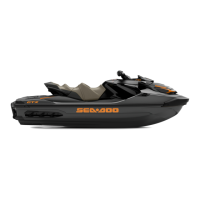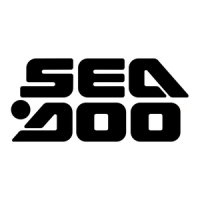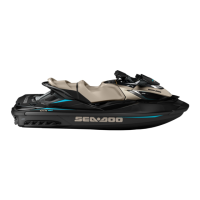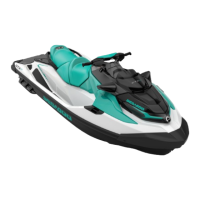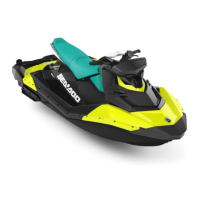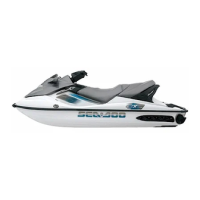Section 08 ENGINE MANAGEMENT (4-TEC)
Subsection 01 (OVERVIEW)
Fuel injection
system
Ignition system
Starting system
Data transfer
with VCM
DESS system
and learning
key
RPM limiter
Limp home
mode
Engine
Control
Module
(ECM)
R1503motr334A
Engine
Management
System
(EMS)
EMS FUNCTIONS
The ECM gets its power by the MPEM which is di-
rectly powered by the battery. It is responsible for
the following engine management/electrical func-
tions:
– interpreting information
– distributing information
– start/stop function
– DESS (Digitally Encoded Security System)
– ignition timing control
– injection control
– The ECM applies the proper map (injection and
ignition) for optimum engine operation in all con-
ditions.
– engine RPM limiter
– etc.
The ECM features a permanent memory that will
keep the programmed safety lanyard(s) active,
fault codes and other engine information, even
when the battery is removed from the watercraft.
EMS — GENERAL FUNCTIONS
Safety Lanyard Reminder
If engine is not started within 5 seconds after in-
stalling the safety lanyard on its post, 4 very short
beeps every 3 second interval will sound for ap-
proximately 4 hours to remind you to start the en-
gine or to remove safety lanyard. Afterwards, the
beeps will stop. The same will occur when safety
lanyard is left on its post 5 seconds after engine is
stopped.
Always ensure safety lanyard is not left on its post
after engine is stopped.
IMPORTANT: Leaving the safety lanyard on its
post when engine is not running will slowly dis-
charge the battery.
Antistart Feature
This system allows starting the vehicle only with
safety lanyard(s) that has been programmed to op-
erate a specific watercraft. This functionality is
the DESS system. See below for details.
Digitally Encoded Security
System (DESS)
The following components are specially designed
for this system: Multi-Purpose Electronic Module
(MPEM), ECM, safety lanyard cap and safety lan-
yard post.
The safety lanyard cap contains a magnet and a
ROM chip. The magnet actually closes the reed
switch inside the post which is the equivalent
of a mechanical ON/OFF switch. The chip has a
unique digital code.
The DESS circuitry in the ECM is activated at the
factory. Therefore, a safety lanyard must be pro-
grammed to start the engine.
When ordering a new ECM from the regular parts
channel, the DESS circuitry will be activated.
NOTE: Actually, it is the memory of the ECM
whichisprogrammedtorecognizethedigitalcode
of the safety lanyard cap. This is achieved with
the VCK (Vehicle Communication Kit) (P/N 529 035
981). Refer to B.U.D.S. help system to program
a safety lanyard.
The system is quite flexible. Up to 8 safety lan-
yards may be programmed in the memory of the
watercraft ECM. They can also be erased individ-
ually.
The ECM also offers a special safety lanyard — the
Sea-Doo LK™ (learning key) — which can be pro-
grammed so that the vehicle can be run only at a
limited speed — approximately 55 km/h (35 MPH).
Such feature is ideal for first time riders or renters.
WARNING
When programming a Sea-Doo LK™ (learn-
ing key), use only a lanyard that is identi-
fied for that purpose. Otherwise, a customer
could use a vehicle with a greater speed than
he was expecting.
smr2004-Complete Line Up 397
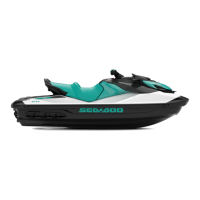
